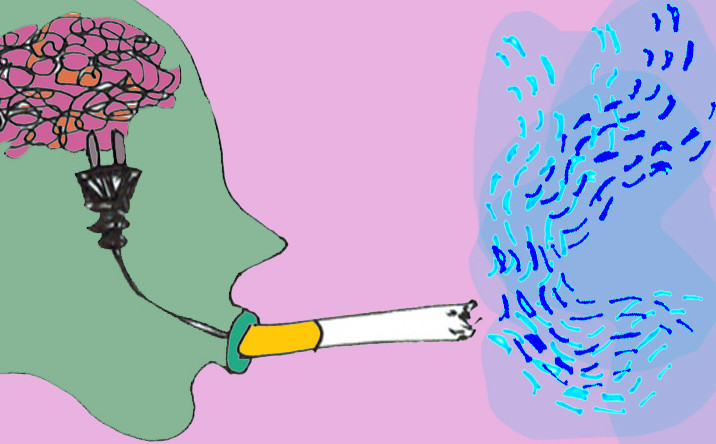The electronic cigarette, or the e-cigarette, is an old product revolutionized by a sleek, modern platform. Instead of burning tobacco, a small, battery-powered device converts liquid nicotine into vapor. Although e-cigarettes’ safety has not been conclusively researched, they don’t contain the tar or carbon monoxide of traditional cigarettes. Today, a subculture of “vapers” frequent e-cigarette lounges, which target younger, more health-conscious populations. In this way, e-cigarettes introduce a paradigm shift by presenting nicotine as a relatively harmless substance — a marked contrast to nicotine’s carcinogenic history. As a healthier, less expensive alternative to traditional cigarettes, e-cigarettes could actually level the current negative impact of cigarettes across U.S. socioeconomic strata.
Although the number of smokers has fallen in the United States after decades of public campaigns and policies targeting tobacco use, the decline has not been uniform. While the wealthiest families saw a 62 percent drop in smoking from 1965 to 1999, those in the lowest income bracket experienced only a 9 percent decrease in the same time period.
Among the policies to combat tobacco is the sin tax — the most damaging to economically vulnerable segments of society and the least effective when curbing demand. Despite the overall decline in smoking, revenues from tobacco taxes have shown significant and steady yearly growth. Preying on inelastic demand does little besides generate revenue. In addition, sales taxes are functionally regressive — because all consumers pay the same amount of money for a product, those with a lower income pay proportionally more of theirs than someone with a higher income. And the regressive nature of the cigarette sales tax is exacerbated by the fact that lower-income people smoke in higher proportions. This problematic side effect of the current economic distribution of smokers could be reversed if e-cigarettes took hold. They are a relatively harmless vice that appeal to a wider range of consumers — and a less expensive alternative to traditional cigarettes, with the possibility of creating a more even distribution between wealthy and less wealthy households.
Another downside of sin taxes is that they threaten to starve out the flourishing boutique industry of vaping culture. Italy’s recent experience is a pertinent warning against such policies: its e-cigarette industry, once booming at three-figure growth rates, came to a grinding halt after the state levied a heavy sin tax on the product. The tax deterred consumers, but its consequences did not stop there — small businesses and startups shied away, evidenced by a 99 percent decrease in e-cigarette business license requests just two months after the tax was levied.
E-cigarettes also present a unique opportunity for the tobacco industry to finally diversify. Prohibitive policies like sin taxes allow Big Tobacco — a powerful lobbying force — to maintain control of the nicotine industry. Established tobacco companies have the capital needed to absorb high taxes, and have indeed shown an interest in the nascent boutique industry, evidenced by the U.S. company Lorillard’s $135 million purchase of Blu eCigs in 2012. While the e-cigarette industry isn’t particularly diversified, increasing taxes and threatening strict regulation will only serve to further discourage startups that could help e-cigarettes thrive and combat the negative influences of an oligarchy.
The best counterpoint to the emergence of e-cigs is the feared unraveling of years of public health progress. In addition to levying prohibitive economic policies, the anti-smoking campaign has largely centered on fighting the symbolic appeal of cigarette smoking — one that has long been tied up in marketing strategies that emphasize rebelliousness and sexuality. Because this battle has so heavily targeted the visual allure of smoking, the potential of e-cigarettes to re-normalize the finger-to-lip gesture would undo the work of many years and millions of dollars.
Renormalization, however, would help diminish the socioeconomic disparity between smokers and non-smokers. If e-cigarette usage can avoid the stigmatization of regular cigarettes, more people might indulge in them than they would in regular cigarettes. Their lower health risks would also lessen the socioeconomic gap seen in the physical and economic costs borne by cigarette users. In order to accomplish this, however, e-cigarettes would have to take control of the entire nicotine industry, spreading awareness of their product and its benefits across socioeconomic strata. No good comes of the upper classes puffing on less carcinogenic alternatives while the poor continue eroding their health on traditional cigarettes. The U.S. e-cigarette industry may have doubled its sales figures from 2011 to 2012, but it is still a niche market when compared with traditional cigarettes — making just $1.7 billion versus the latter’s $80 billion this year.
The e-cigarette provides a unique opportunity to wean smokers off of its carcinogen-heavy predecessor and reduce the sociological impact of cigarette taxation — currently shouldered disproportionately by low-income populations. The potential benefits from a larger e-cigarette industry are many, but the appeal of the product alone will not be enough to reform the industry, not only because of structural barriers to raising awareness, but also because of the threat of increased regulation. All this potential is close enough to touch, but if mishandled, it threatens to vaporize on the horizon. υ
